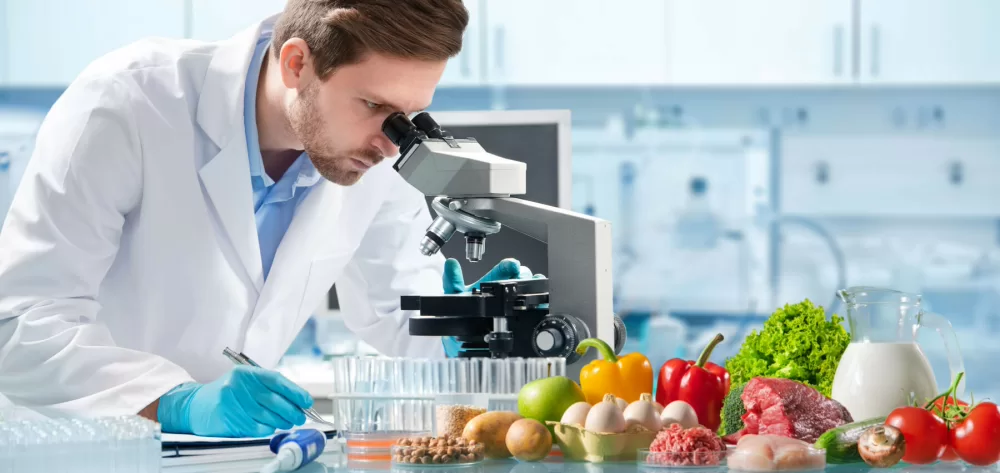Demand for nourishment continues to grow along with the growing global population. Some investors see this challenge as a chance. This moneyland.ch guide answers the most important questions about investing in future foods.
What does the term future foods refer to?
There are a number of criteria that must be met for a substance to be considered a future food. These criteria are based on challenges affecting climates and demographics. Possible factors include:
- High demand: The world’s population is growing – and demand for foodstuffs is growing with it. According to United Nations estimates, around 9.7 billion people will share planet earth by 2050. Many experts believe that food production will have to radically increase in the coming decades to continue meeting the demand.
- More efficient use of farmland: Many experts believe that a shift to more efficient farming methods – including through technological innovations – is necessary in order for food production to keep up with population growth.
- Alternative food sources: Demand for animal-based foods like meat and milk products continues to grow worldwide. But the production of these foodstuffs comes with a relatively large environmental footprint. Because of that, many companies are working to develop more climate-friendly and resource-efficient alternatives. Examples include plant-based meat substitutes and cultivated meat – meat produced by culturing animal cells.
Due to the forced growth in demand for foodstuffs, some investors believe thematic exchange-traded funds (ETFs) that focus on future foods have the potential to yield high returns.
Which foodstuffs qualify as future foods?
There are a number of foodstuffs that are often referred to in connection with future foods. Examples of commodities that experts believe have the potential to become major food sources include:
- Algae
- Legumes
- Insects
- Cultivated meat
- Plant-based meat and milk substitutes
Are there any future food stock indexes?
There are a number of global stock indexes that are focused on innovative companies in the biotechnology, agriculture, and food processing sectors. Common factors across all of these indexes include large US components and a relatively small number of tracked stocks. Of the indexes listed in Table 1, not one includes more than 62 stocks (as per October 2024). By comparison, the global stock index MSCI World includes more than 1400 stocks (as per October 2024). Even other indexes that also track specific themes often include much more stocks.
Table 1: Overview of future food stock indexes
| Index |
Number
of stocks |
Most
heavily-weighted
stock |
Number
of countries |
Most
heavily-weighted
country |
Foxberry Tematica Research
Sustainable Future of Food
NTR Index |
55 |
Beyond Meat (3.40%)* |
15* |
USA (52.92%)* |
MVIS Global Future of Food
ESG Index |
35 |
Sprouts Farmers
Market (9.04%) |
11 |
USA (54.04%) |
Solactive AgTech and Food
Innovation Index |
30 |
Corteva (13.53%) |
11 |
USA (47.0%) |
Solactive Sustainable Food
Index |
62 |
Deere & Company (4.16%) |
14 |
USA (53.4%) |
Source: Index publishers. Date: October 23, 2024.
*Source: Rize Sustainable Future of Food UCITS ETF
Are there any Swiss companies in the future food sector?
Swiss companies are relatively well represented in four indexes listed in Table 1. Only the Solactive AgTech and Food Innovation Index does not include any Swiss stocks. Swiss companies tracked by future food indexes include:
- Bucher Industries manufactures machinery for the production of many different groceries. Examples include farm machinery and machines used in the production of wine and fruit juice.
- Emmi is Switzerland’s largest dairy processor. In addition to conventional milk products, the company also produces dairy substitutes.
- Givaudan supplies food producers with aromas and flavor enhancers, and is the global leader in its field.
- The SIG Group develops packaging solutions for the food processing industry, such as packaging technology for milk products.
Table 2: Swiss stocks included in future food indexes
| Company |
ISIN |
Sector |
Headquarters |
| Bucher Industries |
CH0002432174 |
Machinery |
Niederweningen |
| Emmi |
CH0012829898 |
Dairy products |
Luzern |
| Givaudan |
CH0010645932 |
Aroma, fragrances |
Vernier |
| SIG Group |
CH0435377954 |
Packaging |
Neuhausen am Rheinfall |
Date: October 23, 2024.
Which ETFs can I use to invest in future foods?
There are a number of ETFs that replicate future food indexes. These include some actively managed ETFs that stand out because of their higher fees. The fees charged by a fund are shown as the total expense ratio (TER).
Table 3: Overview of future food ETFs
| ETF |
ISIN |
TER |
| Foxberry Tematica Research Sustainable Future of Food Index |
| Rize Sustainable Future of Food UCITS ETF |
IE00BLRPQH31 |
0.45% |
| MVIS Global Future of Food ESG Index |
| VanEck Sustainable Future of Food UCITS ETF |
IE0005B8WVT6 |
0.45% |
| Solactive AgTech and Food Innovation Index |
| Global X AgTech and Food Innovation UCITS ETF USD Accumulating |
IE000EBFYWX3 |
0.50% |
| Solactive Sustainable Food Index |
| Franklin Future Of Food UCITS ETF |
IE000ZOKLHY7 |
0.30% |
| Aktiv verwaltete ETF |
| Ossiam Food for Biodiversity UCITS ETF 1A (EUR) |
IE00BN0YSK89 |
0.75% |
| Ossiam Food for Biodiversity UCITS ETF 1A (USD) |
IE00BN0YSJ74 |
0.75% |
Source: ETF managers. Date: October 24, 2024.
The ETFs listed in Table 3 all use physical replication. That means the fund’s manager actually invests in the underlying stocks.
Additionally, all of the listed ETFs are accumulating funds. That means dividends are automatically reinvested in the fund instead of being paid out.
Another factor that the ETFs in Table 3 have in common is that they are all domiciled in Ireland.
You can find more information about index replication methods, dividend models, and fund domiciles in the checklist for choosing an ETF.
Compare stock brokers
On top of the fees charged by the fund itself (the TER), there are some other costs you should pay attention to when investing in ETFs. These include possible brokerage fees and custody fees charged by your stock broker. There are big differences in the fees charged by different stock brokers. These fees can have a big impact on your investment returns. You can save a lot of money by comparing stock brokers on moneyland.ch and choosing the most affordable broker for your specific investment needs.
You can find detailed information about the costs of buying and selling shares in ETFs in the checklist for choosing an ETF.
What are the possible risks and issues of investing in future foods?
Investing in future food ETFs comes with a number of risks:
- Speculation: Titles like “future of food” are a good indicator of just how speculative future food ETFs are. There is no way to accurately predict which products will see increased demand in the future. That is especially true of concepts and technologies that are relatively new and unestablished.
- Poor diversification: Investing only in ETFs that rigidly follow a specific theme can result in poor diversification. All of the future food ETFs listed in Table 3 invest in just 62 companies or less. Additionally, the companies they invest in are only spread over a handful of industry sectors, all of which are linked to food production.
- Unimpressive past performance: In the recent past, nearly all of the ETFs listed in Table 3 performed worse than the market as a whole (see Table 4). It is important to note, though, that past performance is not a sure indicator of future returns. The short length of time for which information is available also limits the value of historical performance as a market indicator.
Having a broadly-diversified investment portfolio – such as one based on a global stock index – drastically reduces your risk of losing money. Future food ETFs should primarily be used to further diversify your portfolio. For example, you could consider using a future food ETF as a satellite in a core-satellite portfolio with a diversified global index at its core.
Is investing in future food ETFs profitable?
A comparison of performance over the past year shows that with just one exception, future food ETFs had poorer performance than an ETF based on the MSCI World global stock index.
A look at longer-term performance paints an even clearer picture: The performance of the VanEck Sustainable Future of Food UCITS ETF since its founding in June 2022 is substantially lower than that of the MSCI-World-ETF over the same period.
Table 4: Performance comparison of future food ETFs and a global ETF
| ETF |
Index |
1-year-performance
in CHF (2023-2024) |
4-year-performance
in CHF (2020-2024) |
VanEck Sustainable Future
of Food UCITS ETF |
MVIS Global Future of Food
ESG Index |
37.64% |
|
UBS ETF (IE) MSCI World
UCITS ETF (USD) A-dis |
MSCI World |
31.61% |
55.63% |
Ossiam Food for Biodiversity
UCITS ETF 1A (USD) |
ohne Index |
22.32% |
|
Rize Sustainable Future of
Food UCITS ETF |
Foxberry Tematica Research
Sustainable Future of Food
NTR Index |
17.21% |
-23.68% |
Franklin Future Of Food
UCITS ETF |
Solactive Sustainable
Food Index |
16.81% |
|
Global X AgTech and Food
Innovation UCITS ETF
USD Accumulating |
Solactive AgTech and
Food Innovation Index |
1.64% |
|
Source: Justetf.com. Performance in CHF, accounting for dividends. Dates used for the performance comparison: October 23, 2020; October 23, 2023; October 23, 2024.
Be aware that performance data can only serve as a point of reference, at best. Past performance is not a reliable indicator of future price developments.
The future food ETFs listed here are all relatively new funds, so there is little historical data available. This means the historical performance figures have only marginal value if you are looking to invest over long terms. Investments in ETFs should, ideally, be held for many years or even for decades. But the future food ETFs shown in this guide have only been in existence for a few years.
Important: This article is provided for informational purposes only, and should not be considered investment advice. The publishers do not accept any liability in connection with this article.
More on this topic:
Compare Swiss stock brokers now
How to invest money in Switzerland
How to invest in momentum stocks
How to invest in low-volatility stocks
How to invest in global stock indexes


 Deal of the Day
Deal of the Day 




